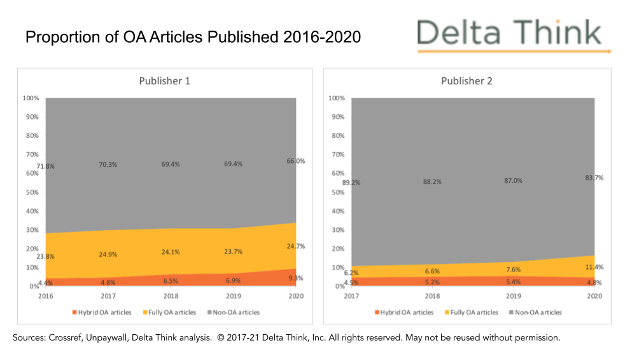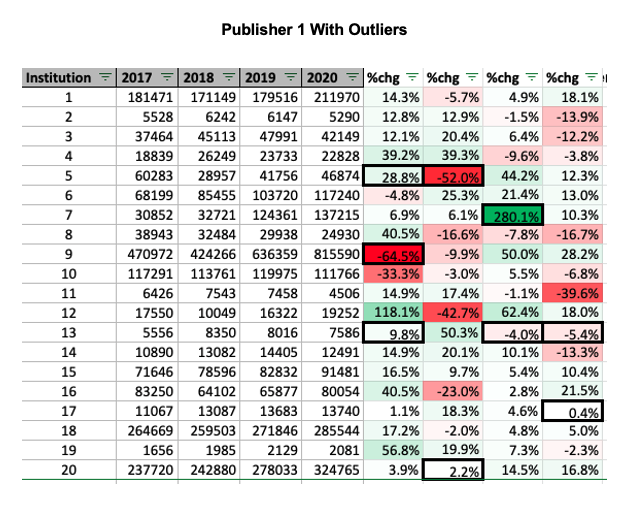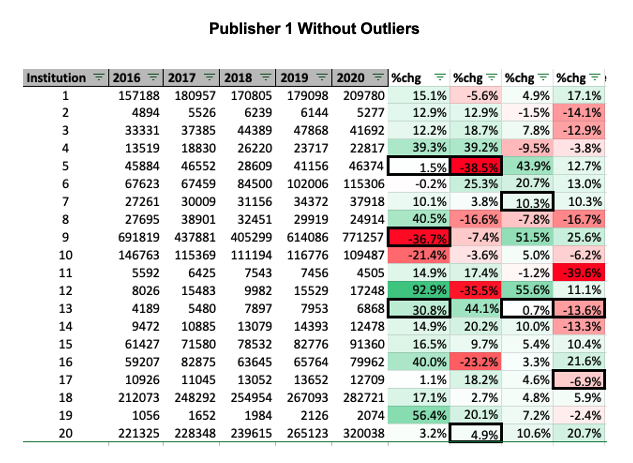This month’s News & Views is derived from ongoing research involving Michael Levine-Clark, John McDonald, Jason Price, and Heather Staines. This content, and the May News & Views, is based on a session presented at the Charleston Conference in November 2021.
How does the growth of a particular publisher’s open access content factor into the relative value of a Big Deal?
As open access publishing has grown, libraries have begun to question the value of their expensive Big Deal subscriptions. Data from Delta Think show that OA articles account for an increasing percentage of overall publishing. This study examines those data as well as usage data from library subscriptions to determine whether the overall value of Big Deals is decreasing. Included in this study is a detailed explanation for how to remove outliers to create a more reliable data set – an important component of any study, and one that could be used by librarians who wish to perform a similar analysis on their own collections. Part 2 (to be published in the May News & Views) will include the findings of this study, which are informed by information from the Delta Think Open Access Data & Analytics Tool.
This study utilizes COUNTER usage data from twenty libraries [note: eight libraries are Carnegie Research 1 (or Doctoral Very High Research Activity) and 12 others range from R2 (or High Research Activity) down to small baccalaureate] – all chosen because they had Big Deals with the publishers used in this study. The study used two large publishers with a mix of gold, hybrid, and non-OA titles across a four to five year period (note: 2016-2020 and 2017-2020 respectively).
Using data about those two publishers from Delta Think, we see that open access publication is possible – via either gold or hybrid journals – across 85-95% of the publisher portfolio – slightly higher for Publisher 2 (Figure 1).

When we look at the articles actually published, the numbers are lower. Gold articles ranged from about 23% to 25% of publishing output for Publisher 1, while OA articles in hybrid journals increased from 4.4% to 9.3% over five years. Publisher 2 follows the same pattern but with 6.5% to 11.5% gold and a fairly consistent 4.3% to 5.4% for hybrid over four years. Both publishers show an increase in gold articles as a percentage of total output over time. Hybrid increases slightly for Publisher 1 and decreases slightly for Publisher 2. (Figure 2) It is important to keep these numbers in mind as we turn to usage data.

We looked at COUNTER 5 Title Master Reports for each library, noting in particular Access Type, which divides usage into Controlled and OA gold. We cleaned up the data to remove fully OA journals, which would be open on the publisher website whether or not a big deal was in place. However, if gold titles also showed controlled usage, we kept these in, assuming that only a subset of the journal run was open. Usage in hybrid journals was retained.
We also removed outliers whose usage seemed to indicate that something unusual had happened, potentially a breach. Our exclusion criteria took out any title that had over 1,000 requests in a single year, but fewer than 100 in the previous or following year, or any time when the total for one year was more than two times all other years’ totals combined. For example, if there was a title that had 4,000 uses in one year, but the other four years added up to less than 2,000, we removed that title as well. Outliers removed based on this sort of pattern included 863 university-by-journal combinations in all (out of a total of 143,833) or about 0.6% of the total usage.


The difference between the overall year-over-year percentage change numbers before and after removing outliers is quite dramatic in some cases (see bold borders) especially given that so few university-by-journal combinations were removed.
Now that the data clean-up is done, the analysis can begin. We’re presenting the methodology above to underline the care and attention with which an inquiry moves from the question one would ideally like to ask to consideration of what is possible given the available data, both on the institutional usage and the information on publisher output by license type. Subscribers to the Delta Think Open Access Data & Analytics Tool can easily check the output of hybrid articles by publisher, as well as trends over time. Combining this information with COUNTER usage statistics can answer key questions, such as the one asked in this case.
Stay tuned for the outcome of this research in our May News & Views!
This article is © 2022 Delta Think, Inc. It is published under a Creative Commons Attribution-NonCommercial 4.0 International License. Please do get in touch if you want to use it in other contexts – we’re usually pretty accommodating.

TOP HEADLINES
Four Urgent Recommendations for Open Access Negotiations with Publishers – April 1, 2022
“LIBER’s Urgent Recommendations for Open Access Negotiations with Publishers outline four priorities to bolster and integrate library Open Access strategies. Each recommendation comes with suggested actions to put the recommendation immediately into practice and links to additional resources that illustrate the good practice of LIBER member libraries and their partners.”
Diamond Open Access: An academic-led, community-driven, and equitable scholarly publishing model – March 24, 2022
“Science Europe and Coalition S, two organizations spearheading the development of an international Open Access strategy, recently launched an initiative to provide global support for establishing and maintaining the Diamond model. The action plan was made public on March 2, 2022.”
Jisc response to the Elsevier open access agreement – March 23, 2022
“UK universities have reached a three-year agreement with Elsevier providing both unlimited open access publishing and access to paywalled journal articles for a significant reduction on current institutional spend.”
EUA signs Action Plan for Diamond Open Access – March 9, 2022
“EUA has signed up to the “Action Plan for Diamond Open Access” which aims to promote a sustainable, community-driven Diamond Open Access (OA) scholarly communication ecosystem. Published on 2 March 2022, the document is an initiative of Science Europe, cOAlition S, OPERAS and the French National Research Agency (ANR).”
OA JOURNAL LAUNCHES
March 29, 2022 | “The Endocrine Society announced it will launch a new open access, online-only journal featuring reports on clinical cases and clinical problem solving from across the field of endocrinology. JCEM Case Reports will be fully peer-reviewed and begin publishing issues in late 2022.” |

